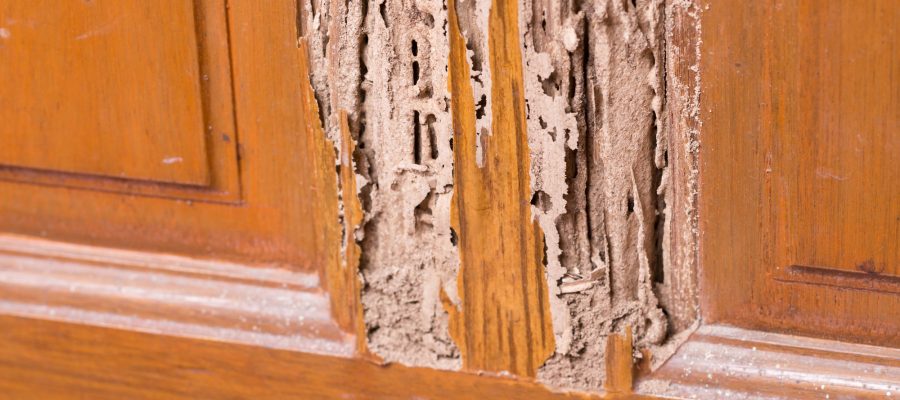Termite Damages: This Is How Fast Termites Can Eat a House
- November 12, 2020
- in Pest Control
- by Ashley Dando

It’s shocking how quickly termites can eat through wood. Each year, termites have been known to cause more than $5 billion in property damage. They make tunnels inside the wood, further damaging the structural integrity of your home.
If you’re wondering how long it takes for termites to eat your home, then you’ve come to the right place. Don’t wait another second before taking action against termites. Keep reading to find out everything you need to know about termite damages.
By the time you see the results of a termite infestation, there may be a lot of damage that’s beneath the surface. How fast do termites eat wood? Termites can spread and eat through wood quickly. This can affect the stability of your home.
If you have termites in your house it’s difficult to say exactly how much damage can take place before you decide to get a termite treatment. The type of termites, the size of the colony, and their location can all determine the amount of damage done. Even the type of infested wood can be a factor.
Termites exist in colonies and even though there are smaller colonies, you may have multiple colonies infesting your home. Together they can do as much damage as a larger colony.
Depending on where you live, you could face termite colonies from 60,000 workers to 3 million. Regions that have a warmer climate mean more months where the termites are active. In colder regions, the termites’ activity drops down during the winter.
An eastern subterranean termite colony’s mature size is about 60,000. On average, this size colony can eat about 1/5 of an ounce of wood in one day. That is equivalent to one foot of a 2×4 pine board in six months.
However, the average size of an eastern subterranean colony contains 300,000 workers. Which can consume about one cubic foot of wood in one year. In the southern U.S. regions, where the climate is warmer, the Formosan subterranean termite colonies live.
These colonies contain an average of three million workers. With a colony that size, they can gorge through one foot of a 2×4 board in just 48 hours! As you can tell, it’s difficult to know the exact rate that the termites in your home are causing damages.
Termites love to feed on wood and moisture. Even if you only see a small hole or minor evidence of termites in your home, there may be a lot more damage beneath the surface.
This can affect the structure of your home even if your home is mainly brick or masonry. Termites can get into the wood parts of your home and wreak havoc. Things like wood paneling can also be susceptible to termite damage.
In addition to structural damage, termites also create a terrible odor in your home. This is from the fecal pellets that they leave behind. Their fecal matter can cause your walls to blister or be discolored.
All of these factors can result in serious repairs and clean up. This can further add up the longer you wait to take action. To be sure that termites aren’t hurting your home, you should do a pest inspection yourself about once or twice a week.
The key to avoiding a termite attack is to maintain a clean environment in your home. Things like water leaks or woodpiles around your home can attract pests such as termites. Be sure to avoid and tree branches that connect to your house as well. These can actually become a bridge for termites to reach your house.
Make sure you clear away any unused fire-wood and don’t leave it lying near your home. Maintain a clean lawn and back yard. These are the best ways to prevent termites from taking refuge in your house.
Antique wooden furniture is also vulnerable to termite attack. Termites like to breed in antique furniture.
Unfortunately, homes that have had termite infestations significantly lose their structural value. So preventing a termite attack before it happens is vitally important to protect your home’s value.
The best way to prevent huge repairs due to termite damages is to spot the signs early. Luckily there are some clear clues that you may have a termite infestation.
First, if you notice blisters on your wood flooring, that could be a sign that termites are below the flooring. This looks almost as though it has water damage. If you notice wood hollowed or damaged on your walls, floors, etc. this could mean that termites have been breaking down the integrity from the inside.
Termites chew through the wood creating a honeycomb interior. This causes the wood to have an empty sound or create long grooves. You may also find termite wings near closed windows, doors, or other areas of access to the outdoors. Termites intentionally pull their wings off when they are in search of a new colony.
Another sure sign is mud tubes that can be seen outside where your house meets in the ground. These are tunnels that termites create to maintain a certain temperature and humidity level so they can next underground while they feed on your home.
If you notice that your home has termite damages then there’s no need to panic. Termite damage should not be left unchecked, the sooner you act the better. Be sure to contact a licensed pest professional who can help.
Think you might have a termite problem? Don’t wait to take action. We can help you save your home with a free estimate. Contact us today!
Array